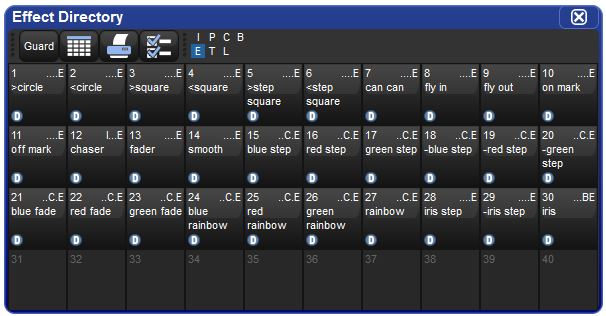You can quickly apply effects to the current selection using predefined effects palettes in the Effect Directory; see Figure 14.4, “The Effect Directory”. Effects palettes for parameter functions not available in the current selection will be greyed out; for example the Iris Step palette is not available for Studio Color 575s as they do not have an iris parameter.
To open the Effect Directory:
Open + Effect
Or:
Effect, Effect
To apply an effects palette:
1Thru5@50Enter : select the required fixtures and assign an intensity valueEffect
13Enter : assigns Effect Palette 13. Studio Colors 1 to 5 fade their intensity between 0 and 100%.
You can also select the effect palette by pressing or clicking on its button in the Effect Directory window.
Once you have applied a predefined effects palette to the selected fixtures, you can alter the attributes (Rate, Size, Offset and Length) of the effect using the parameter wheels; for explanations of the different attributes, see Table Effect Attributes. The Wheels Toolbar shows the current parameter value being assigned by each wheel whenever the Effect key is selected; see Figure 14.5, “The Wheels Toolbar showing Effect Attributes”. For more on the different effect attributes see Table Effect Attributes.
You can record any combination of effect parameter values into a palette:
In the Programmer or editor, select the fixtures, and assign the required effects. You can do this directly in an editor or using the Effects Engine.
Record, Effect : the Effect Directory window opens.
Select a location by pressing a button in the directory window.
This will only record parameters that have been touched in the Effect window, and does not include the parameters' underlying values. To include underlying intensity, position, colour, beam and time information use the mask function:
Select the fixtures, and assign the desired effect table.
Record, Effect
Select Mask from the Record Options Toolbar, and select the parameter types that you wish to record: Use I for intensity, Use P for position, Use C for colour, Use B for beam, and Use T for time values.
For more on masking when recording palettes, see Recording Palettes with Kind Masking.
Select a location from the Effect Directory window.
You can give an effect palette a name that will be displayed in the Effect Directory:
Open + Effect : opens the Effect Directory.
Check that the Guard button is selected, so that you don't accidentally activate a palette when pressing its button in the directory.
Select the palette to be named.
Set
[name]Enter : type in the name.
![[Tip]](../images/tip.png) | Tip |
|---|---|
To name an effect palette immediately after recording it, pressing the Set key will open a Quickname window. Enter the palette name and select OK. |
In the Programmer or editor, you can apply an effect by selecting it from the Effect Directory. The effect will be applied to the current fixture selection, providing that it contains parameter information for the selected fixtures. An iris step effect cannot therefore be applied to a fixture that has no iris function. By default, predefined effect palettes are direct; see Direct Palettes.
For example:
Open + Effect : open the Effect Directory window.
1Thru5: select the fixtures.[Effect 1] : select the effect from the Effect Directory window.
Or, using the command line:
1Thru5Effect1Enter
You can edit an effect palette by opening it in an editor window; you can then edit its contents in the same way as you edit values in any editor. See Building Table Effects in Editors.
To open an effect in an editor:
Open + Effect : open the Effect Directory.
Open + [Effect 1] : open the editor for [Effect 1].
You can select the editor view (Table, Size, Rate, Offset, Length, N Shot) you wish to edit in. Also ensure that the editor is active with its Edit button selected.
You can also open an effects palette with the command line. For example:
Effect
1Open
To delete an effect palette using the command line:
Effect
1Delete : deletes Effect Palette 1.Click OK to confirm the delete.
Or, from the Effect Directory:
Press and hold Delete whilst selecting the palette to be deleted from directory.
Release the Delete key. A dialog will appear asking you to confirm the delete.
Click OK.
![[Tip]](../images/tip.png) | Tip |
|---|---|
If you prefer not to be asked to confirm the delete action, select Don't Ask Me Again in the confirmation window. You can re-enable the confirmation by going to Setup → Preferences → Programming and selecting Confirm before deleting directory items. |
To make a copy of an effect palette in a new location:
Effect
1Copy; Effect;2Enter : copies the contents of Effect Palette 1 to Effect Palette 2.
Effect;
1Position;2Copy Effect2Enter : copies fixtures that are in Effect Palette 1 and in Position 2 into Effect Palette 2.
Similarly, to move an effect palette to a new location:
Effect;
1Move Effect;2Enter : moves the contents of Effect Palette 1 to Effect Palette 2, leaving 1 empty.
If the destination effect palette already exists, you will be asked to choose an option: Insert, Merge and Replace.

